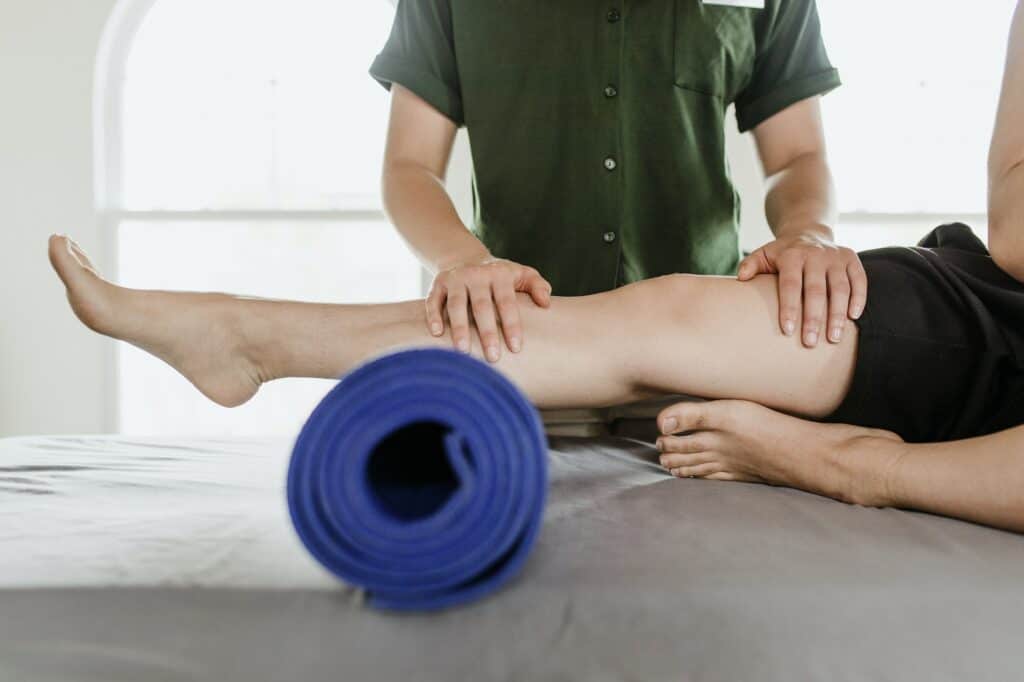Relieving Chronic Pain With Physical Therapy Massage
Do you suffer from chronic pain that won’t disappear, no matter what you try? If so, you’re not alone. Millions of people worldwide live with chronic pain daily, making it difficult to enjoy life to the fullest. However, there is hope. Physical therapy massage is a proven method for relieving chronic pain and improving quality of life. In this blog post, we’ll explore how physical therapy massage can help relieve chronic pain, the techniques used, what to expect during a session, precautions to consider, and much more.
Brief Overview Of Physical Therapy Massage
Physical therapy massage is a manual therapy used to treat musculoskeletal pain and dysfunction. It involves applying techniques, such as kneading, stroking, and pressure, to soft tissues in the body, such as muscles, tendons, and ligaments. A physical therapy massage is performed by a licensed physical therapist trained to assess and diagnose conditions that cause pain and dysfunction. Then, the therapist will develop a personalized treatment plan based on the patient’s needs and goals. The primary goal of physical therapy massage is to reduce pain, increase range of motion, and improve overall function and quality of life. It can treat various conditions, including chronic pain, back pain, neck pain, arthritis, and sports injuries.
Causes Of Chronic Pain
Various factors, including medical conditions, injuries, and lifestyle factors, can cause chronic pain. Some common causes of chronic pain include:
- Arthritis: Arthritis is a common cause of chronic pain, especially in older adults. This condition causes inflammation and stiffness in the joints, leading to chronic pain. There are many different types of arthritis, including osteoarthritis, rheumatoid arthritis, and psoriatic arthritis, each with its own symptoms and treatment options. Treatment for arthritis may include medication, physical therapy, and lifestyle changes.
- Fibromyalgia: Fibromyalgia is a chronic disorder that causes widespread pain and tenderness throughout the body. The exact cause of fibromyalgia is unknown, but it is believed to be related to abnormalities in how the brain and spinal cord process pain signals. In addition to pain, fibromyalgia can cause fatigue, sleep disturbances, and mood disorders. Treatment for fibromyalgia may include medication, physical therapy, and lifestyle changes.
- Back And Neck Injuries: Injuries to the back or neck, such as herniated discs or whiplash, can cause chronic pain. These injuries can result from accidents, falls, sports injuries, or other types of trauma. Treatment for back and neck injuries may include physical therapy, medication, and in some cases, surgery.
- Nerve Damage: Nerve damage caused by diabetes or chemotherapy can cause chronic pain. This type of pain is often described as a burning or tingling sensation and may be accompanied by numbness or weakness in the affected area. Treatment for nerve damage may include medication, physical therapy, and in some cases, surgery.
- Postural Problems: Poor posture can cause chronic neck, back, and shoulder pain. This is because sitting or standing in a reclined position puts extra pressure on our muscles and joints. Over time, this can lead to chronic pain. Treatment for postural problems may include physical therapy, stretching exercises, and ergonomic adjustments to your work environment.
- Stress: Emotional stress and tension can cause chronic pain, especially in the neck, back, and head. This is because stress causes our muscles to tense up, leading to pain and discomfort. Treatment for stress-related chronic pain may include relaxation techniques, stress management, and counseling.
- Repetitive Strain Injuries: Overuse injuries from repetitive motions, such as typing or playing an instrument, can cause chronic pain. These injuries are often caused by small, repetitive movements that strain our muscles and joints. Treatment for repetitive strain injuries may include physical therapy, stretching exercises, and ergonomic adjustments to your work environment.
- Surgery: Some people experience chronic pain after surgery, significantly if nerves are damaged during the procedure. This type of pain is often described as a burning or shooting sensation and may be accompanied by numbness or weakness in the affected area. Treatment for post-surgical chronic pain may include medication, physical therapy, and in some cases, additional surgery.
Benefits Of Physical Therapy Massage For Chronic Pain Relief
Physical therapy massage can provide numerous benefits for chronic pain relief. Here are some of the main benefits:
- Reduces Muscle Tension and Inflammation: Physical therapy massage works by relaxing tense muscles and reducing inflammation, which can be a significant source of chronic pain. By doing so, it helps to alleviate the discomfort associated with chronic pain.
- Increases Blood Flow and Range of Motion: Massage therapy can increase blood flow to the affected area, which promotes healing and reduces pain. It can also help to improve the range of motion in the affected area, making it easier to move without pain.
- Releases Endorphins: Physical therapy massage can stimulate the release of endorphins, natural painkillers produced by the body. Endorphins can help to reduce the perception of pain and improve overall mood.
- Improves Sleep: Chronic pain can often disrupt sleep patterns. Physical therapy massage can help enhance sleep quality by promoting relaxation and reducing pain. By doing so, it can help individuals with chronic pain to achieve better rest and feel more refreshed.
- Reduces Reliance on Pain Medication: Physical therapy massage provides natural pain relief, which can help to reduce the need for pain medication. This is particularly beneficial because pain medication can have unwanted side effects and can be addictive.
- Improves Overall Quality of Life: Chronic pain can be debilitating and affect many areas of life. Physical therapy massage can help improve overall quality of life by reducing pain, increasing mobility, and improving mood and sleep. By enhancing these critical areas of life, individuals can experience a significant improvement in their overall well-being.
Types Of Physical Therapy Massage Techniques For Chronic Pain Relief
Various physical therapy massage techniques can be used to relieve chronic pain. Here are some of the most common types:
- Deep Tissue/Sports Massage: This type of massage involves deep pressure on the muscles, using slow strokes and friction to reach the deeper layers of muscle and connective tissue. It can be particularly effective for relieving chronic pain in the back, neck, and shoulders, as well as for reducing muscle tension and improving mobility in specific areas of the body.
- Swedish Massage: A gentle massage that uses long, flowing strokes, kneading, friction, and rhythmic tapping to relax the muscles and promote relaxation. It is often used to relieve stress, reduce muscle tension, and improve circulation, making it a good option for people with chronic pain related to stress or tension.
- Thai Massage: A combination of yoga, stretching, and massage techniques, Thai massage can help relieve chronic pain in the back, neck, and joints, promote relaxation, and increase flexibility. It involves using pressure points and assisted stretching to target specific areas of the body, making it a popular option for athletes and people with chronic pain related to physical activity.
- Tui Na: A Chinese massage technique that uses pressure and kneading to stimulate energy flow and promote healing. Tui Na can be effective for relieving chronic pain in the neck, shoulders, and back, as well as for reducing muscle tension and improving overall well-being.
- Reiki: A Japanese technique that involves light touch to balance the body’s energy and promote healing. Reiki can help relieve chronic pain by promoting relaxation, reducing stress and anxiety, and improving overall energy levels.
- Reflexology: A technique that involves applying pressure to specific points on the feet or hands to promote relaxation and relieve pain. Reflexology can effectively relieve chronic stress, tension, or poor circulation pain.
- Cranial Sacral Therapy: A gentle technique that involves applying light touch to the head and spine to release tension and promote relaxation. Cranial Sacral Therapy can be effective for relieving chronic pain related to tension or trauma and improving overall well-being.
- Qi Gong: A Chinese practice that combines breathing, movement, and meditation to promote balance and healing. Qi Gong can effectively relieve chronic pain by reducing stress and tension, promoting relaxation, and improving overall energy levels.
What To Expect During A Physical Therapy Massage Session
During a physical therapy massage session, you can expect the following:
- Evaluation: Your physical therapist will evaluate your condition, including your medical history, areas of pain, and range of motion. This will help them develop a personalized treatment plan.
- Preparation: You will be asked to lie on a massage table, and your physical therapist will provide you with a sheet or blanket for comfort and modesty. They will also explain the massage technique they will be using and answer any questions you may have.
- Massage Technique: The physical therapist will use the chosen massage technique to address your areas of pain and discomfort. This may involve applying pressure, kneading, stretching, or other techniques to relax the muscles and promote healing.
- Communication: Communicating with your physical therapist during the massage session is essential. Let them know if the pressure is too much, if you experience discomfort, or have any questions.
- Duration: A physical therapy massage session typically lasts between 30 and 60 minutes, depending on the treatment plan and your individual needs.
- Aftercare: After the session, your physical therapist may provide you with exercises or stretches to perform at home to help manage your pain and improve your range of motion. Depending on your progress, they may also recommend follow-up sessions or other therapies.
Precautions And Considerations For Physical Therapy Massage
While physical therapy massage can be a safe and effective treatment option for chronic pain relief, there are some precautions and considerations to keep in mind:
- Medical Conditions: If you have any medical conditions or injuries, it’s essential to consult with your doctor or physical therapist before beginning massage therapy.
- Allergies: Be sure to inform your physical therapist of any allergies to oils, lotions, or other massage products.
- Pain Tolerance: Physical therapy massage can sometimes be uncomfortable, especially if you have tight or sore muscles. Be sure to communicate with your therapist if the pressure is too much and if you experience any pain or discomfort.
- Medications: Some medications can affect how your body responds to massage therapy. Be sure to inform your physical therapist if you take any prescription or over-the-counter medications.
- Pregnancy: If you are pregnant, it’s essential to consult with your doctor before beginning massage therapy. Specific massage techniques may not be appropriate during pregnancy.
- Infections: If you have any skin infections or open wounds, it’s best to postpone massage therapy until the condition has healed.
- Sensitivity: Some individuals may be more sensitive to touch, and certain massage techniques may not be appropriate.
- Cost: Physical therapy massage can be costly and may not be covered by insurance. Be sure to consider the cost and discuss payment options with your therapist.
In conclusion, physical therapy massage can be a valuable tool in managing chronic pain. By working with a licensed physical therapist and incorporating massage into a comprehensive treatment plan, individuals can experience reduced pain and improved mobility.
If you’re interested in exploring physical therapy massage as a treatment option, don’t hesitate to contact us today. Our team of licensed physical therapists can evaluate your condition, develop a personalized treatment plan, and help guide you toward a path of healing and pain relief.
Remember, chronic pain doesn’t have to control your life. With the right treatment plan, including physical therapy massage, you can take control of your pain and get back to doing the things you love. So why wait? Contact us today to get started on your journey toward a pain-free life.




